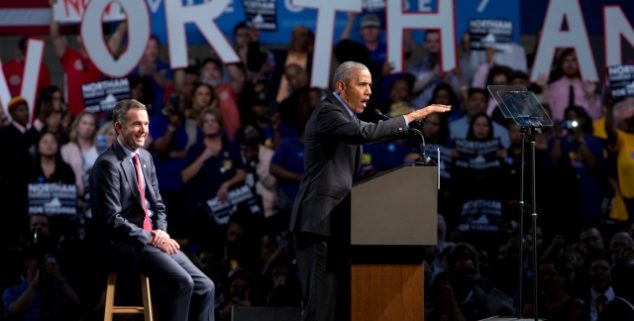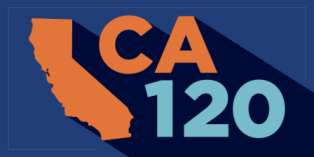News
CA120: Will the wave hit California’s shores?
 Former President Barack Obama, right, waves to the crowd along with Democratic gubernatorial candidate Lt. Gov., Ralph Northam, during an October rally in Richmond, Va. (Photo: Steve Helber/AP)
Former President Barack Obama, right, waves to the crowd along with Democratic gubernatorial candidate Lt. Gov., Ralph Northam, during an October rally in Richmond, Va. (Photo: Steve Helber/AP)With Tuesday night’s Democratic wins in traditional bellwether gubernatorial elections in Virginia and New Jersey, a massive pickup-in the Virginia Legislature, wins in several mayoral races and other assorted gains, the pundits appear locked into the narrative that we are headed for a wave election.
This would follow the pattern we have seen previously, in which the mid-term elections serve as rebalancing against the party in power.
It is still an open question whether this nationalization of our election, and the enthusiasm and turnout that comes with it, will appear in the Golden State.
They include, most famously, the 1994 Republican takeover of congress and the “Contract with America” which made Newt Gingrich a household name. That victory was seen as a direct rebuke of the 1992 victory by Bill Clinton and corresponding wins among members of congress who rode his coattails to election that cycle.
There is little doubt the country is headed into a big 2018 election cycle with a progressive electorate mobilized nearly as much as the Republicans were in 2004 or the Tea Party activists in 2010.
But what does all this mean for California?
It is still an open question whether this nationalization of our election, and the enthusiasm and turnout that comes with it, will appear in the Golden State.
And, if it does, will it find any Republicans to topple? Are those seven GOP-held California congressional districts that voted for Hillary Clinton in 2016 at risk of being won by Democrats?
Wave elections are common. And in the case of Virginia, their odd-year elections have consistently voted against the party of the first-term president. Without the president on the ballot, the mid-term election becomes a kind of proxy-war against the current administration.
With eight years of using the Obama presidency to drive voters, and the benefit of redistricting in most states, the Republican Party has gained wider and deeper control of government than we have seen since the 1920s.
Voters use these elections as a way of pushing back. With higher turnout and more partisan behavior, these reactionary election cycles can be disabling to the party in power.
In several ways, our current state of national politics was created by the reaction to President Obama. His historic election in 2008 was very polarizing, and starting in 2009 Republicans were able to use it to gain expansive majority in congress, governor’s offices and state legislatures.
In the 2009-2010 elections alone, Republicans gained a whopping 721 legislative seats across the country and achieved state government trifectas (holding both branches of the legislature and the governor’s office) in 22 states.
This state-level control had a multiplying-effect: It put Republicans in the driver’s seat going into the 2011 redistricting, and political gerrymandering in many states locked in the wave election’s gains.
With eight years of using the Obama presidency to drive voters, and the benefit of redistricting in most states, the Republican Party has gained wider and deeper control of government than we have seen since the 1920s.
After the wins in Virginia, New Jersey and around the country, Democrats do appear re-energized and likely to experience a wave that will take back much of the ground that Republicans have gained.
Nationally, the GOP controls the Presidency, US. Senate, gained more than 75 members in the House of Representatives and now controls nearly two-thirds of state legislatures and governorships.
For Democrats, to quote an 80’s pop artist, “Things can only get better.”
And it makes sense that things are finally looking up for Democrats.
For the last several election cycles, Republicans were running and winning with the tailwind of a polarizing Democratic president. And, whatever power that gave them is now being countered by the headwind of a polarizing president from their own party.
Even before this recent set of bellwether elections, Democrats had seen a number of extremely close congressional specials where, despite not winning, they saw record fundraising and in some cases a 20-point Democratic shift in the electorate.
Now, after the wins in Virginia, New Jersey and around the country, Democrats do appear re-energized and likely to experience a wave that will take back much of the ground that Republicans have gained.
In the years since, Democrats have continued bucking the national trend, winning even more legislative and congressional seats in California.
For California political observers there is a tendency to see this dynamic on the national stage and presume this same is headed to the Golden State.
But that might not be the case.
There are three elements to this national Democratic wave that just might not play out in California.
First, California didn’t experience a Republican wave election after Obama.
During the national drubbing of Democratic lawmakers in 2009-2010, and the 721 legislative flips, California was the only state where Democrats expanded their legislative majority (when Dr. Richard Pan won a seat previously held by Roger Niello).
In the years since, Democrats have continued bucking the national trend, winning even more legislative and congressional seats in California.
While the statewide redistricting didn’t gerrymander for partisanship, the nonpartisan redraw made it easier for Democrats to gain two-thirds majorities in the Assembly and Senate and control all but 14 of the state’s 53 congressional districts.
Many of the dense high-voter turnout communities in Virginia are basically suburbs of Washington, D.C. They see the national issues front-and-center of its politics.
Nationally, the low-hanging fruit for Democrats are the members of congress, legislators and governors who were elected in these big waves and might not have been elected without the anti-Obama vote.
But, in California you can’t find any of these. There’s literally no statewide, legislative or congressional elected official in California who fits this mold.
The Republican members of Congress and the Legislature who are still in office in California today are survivors of big Democratic sweeps in 2012 and especially 2016, an election that saw Orange County vote Democratic for the first time in the state’s history, yet saw all their Republican members of congress survive.
Secondly, California elections aren’t as easily nationalized.
Many of the dense high-voter turnout communities in Virginia are basically suburbs of Washington, D.C. They see the national issues front-and-center of its politics, on their nightly news and everywhere else they get information.
When I worked on elections in Delaware, New Jersey and North Carolina, it was like working on an extension of D.C. politics.
We just saw an election for an open California congressional seat draw just 15% turnout, and the subsequent Assembly election garner 10.5%.
Elections are easily nationalized in many parts of the country while in California, the presidency feels very far away.
We just saw elections around the country with victories for the country’s first transgender legislator, a council victory for a Black Lives Matter activist, and a vote in Maine to expand Obamacare in elections based on messages and turnout directly rebuking the Trump administration.
In Los Angeles municipal elections, dozens of campaign ads tried to directly hit Trump in order to create this same kind of motivated electorate, yet more LA voters went to protests than actually cast ballots. Without having the President on the ballot, it is hard to connect the anger about the national administration with the rather mundane act of voting.
And that relates to the final thing that seems to be missing in California – turnout.
While we’ve seen huge turnout around the country since the 2016 General election, including spikes in Georgia, Kansas and South Carolina, California elections in 2017 have been dismal. We just saw an election for an open Congressional seat draw just 15% turnout, and the subsequent Assembly election garner 10.5%.
Turnout in California gubernatorial elections is traditionally depressed among the younger, minority, and lower socioeconomic voters that make up the core of the Democratic coalition. And while we have seen evidence of these populations over-performing nationally, we have yet to see any of it here in the Golden State.
Based on past gubernatorial elections, Republicans should actually have a turnout advantage in 2018, one that should make the extremely close races of 2016 a little safer — despite the likely national wave.
So, for Republicans, there is a reason to be somewhat optimistic going into the next election cycle. And, for Democrats, there is a steep uphill battle to overcome these historic trends. It will take more than a wave for California to have its Virginia moment.
—
Ed’s Note: Paul Mitchell, a regular contributor to Capitol Weekly, is the editor of the CA120 political column and the vice president of Political Data, which markets campaign information to both major parties.
Want to see more stories like this? Sign up for The Roundup, the free daily newsletter about California politics from the editors of Capitol Weekly. Stay up to date on the news you need to know.
Sign up below, then look for a confirmation email in your inbox.

Leave a Reply